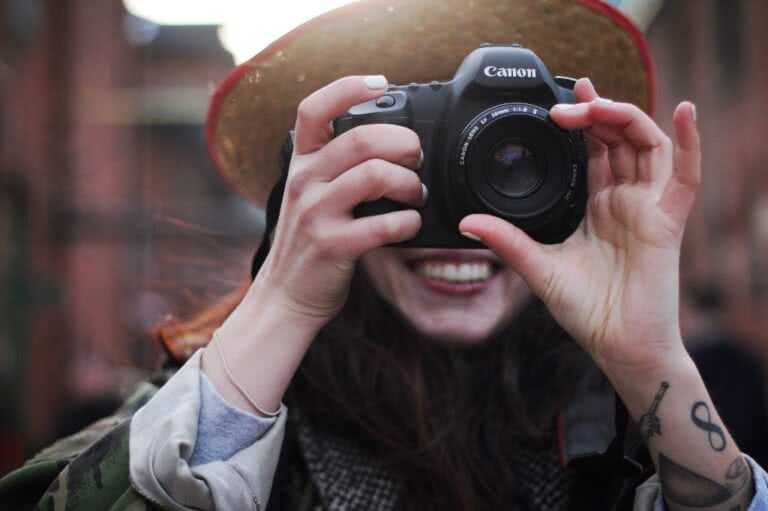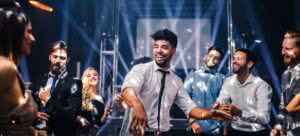Don’t let lackluster images dull potential attendees’ enthusiasm. To make your event photography stand the test of time — and, more importantly, motivate potential attendees to buy tickets — you need to transport viewers to the live experience.
Before picking up a camera — or the phone to hire a photographer — you need to have a vision for your photographic style. Whether you’re working with a professional or relying on staff to get shots for Instagram, these compelling event photography tips will uplevel your photos and help you sell more tickets.
Event Photography Tips # 1: Compose your event photography with your key message in mind
Keep the composition of photos simple to avoid distractions. “Consider before you shoot: what is the key message you want to convey?” says Brian Beaver, VP of Design at Eventbrite.
Beaver has more than 20 years of photography and design experience, and his photos have been featured in numerous print publications. “Then be really deliberate and intentional as you frame the photo. Remove anything extraneous that might conflict or compete with your main message.”
Beaver recommends you follow what’s known in photography as the “rule of thirds.” Divide a frame into thirds both horizontally and vertically, and align the focal point of the photo at a third of the way into the frame. “The rule of thirds is a simple, useful compositional technique to make photos that are more compelling,” Beaver says.
Following this rule helps you create more dynamic images. For example, by placing the “horizon” at the upper or lower third of the image, you create a composition that is more interesting to the eye.
If you’re hosting a business event or dinner where everyone is seated, you may have to get creative with event photography techniques to get a variety of compositions.
“To keep the photos interesting, keep angles interesting,” says Christie Connell, the owner of Azure Photo Studio who shoots countless events of all kinds every year. “If there are floral arrangements, you can shoot between them. If it’s at a restaurant, go outside and take a picture looking in through the window. Look at the event not just as a participant, but from an outsider’s perspective, to get a broader sense of the day.”
Event Photography Tips #2: Capture the perspective of the attendee
“In event photography, the objective is generally to give prospective attendees the feeling or vibe, and allow them to imagine being at your event,” Beaver says. “Their minds don’t have to make that leap if you show the event from the attendee’s perspective. Pull the viewer into the action, so they’re an active participant and not a passive observer.”
For instance, if you’re hosting a cooking class, it may be more valuable to show bowls of ingredients from a top-down first-person perspective, rather than just wide shots of people enjoying class. Put yourself in the attendee’s shoes, so that potential attendees can do the same.
That said, don’t be afraid to mix up your shots to reveal the backstage experience.
“It’s really important to shoot from the point of view of the participant, but also to bring somebody into an experience they wouldn’t ordinarily see,” says Misha Vladimirskiy, a partner at Filterless.co who has photographed events like Coachella and specializes in nightlife and music photography. “Try a backstage photo of an artist, or a unique aerial angle of an event.”
Event Photography Tips #3: Get more creative with event photography shots
While most events will want a variety of shots of attendees — both candid and posed (or “grip and grin” shots, as photographers call them) — challenge yourself to get more creative.
“Often event organisers just want the ‘grip and grin,’” says Vladimirskiy. “That works with interesting or famous people, but when you’re doing a dinner or a speaking engagement or a fashion show, it gets repetitive. Trust your photographer’s creativity, and you’ll get images that will endure and stand alone on Instagram.”
Another note: while it’s important to get shots of attendees having fun, it’s also important to get more abstract shots that aren’t focused on individuals.
“As people we focus on faces,” Beaver says. “That can be positive and powerful — but it can also be a distraction. So if you’re trying to portray a professional networking event, it may be easier for the attendee to imagine themselves within the scene of an abstract image with a slight blur.”
Event Photography Tips #4: Focus on proper lighting to avoid extra edits
“If you’re not a photographer, don’t worry about the setting on your camera,” advises Joe Montana, a freelance photographer in San Francisco. “The most important thing is to capture great moments. Focus on finding that decisive moment and capturing it.”
In the process, try to take advantage of the natural lighting in your venue, and avoid using flash (especially on-camera flash). “Where possible, capture natural lighting, and avoid artificial lighting and flashes,” Beaver says. “Unnatural light makes your image inherently feel like a photograph, and takes viewers out of the moment.”
If you do need flash and are taking shots of attendees, have them turn an eighth of an inch to the side so they’re not facing the camera head-on. “This will reduce red eye in your pictures, because that’s caused when light enters the subject’s eyes at a right angle,” says David Silverman, owner of David Silverman Photography. Silverman earned his event chops photographing events like galas and Brown and Yale University athletic games, and most recently photographed the 2017 Super Bowl.
Once you’ve gotten a great shot, make minor improvements — but be sure not to let post-production effects disconnect viewers from the moment.
“At Eventbrite, we deliberately avoid applying filters or effects to an image,” Beaver says. “Unnatural effects tend to introduce visual obstacles, making it harder for prospective attendees to imagine themselves at your event.”
Ultimately, you don’t have to be a creative genius to articulate what you’re looking for and make it a reality. “With these basics, even the most amateur photographer can create nice images,” says Beaver.





